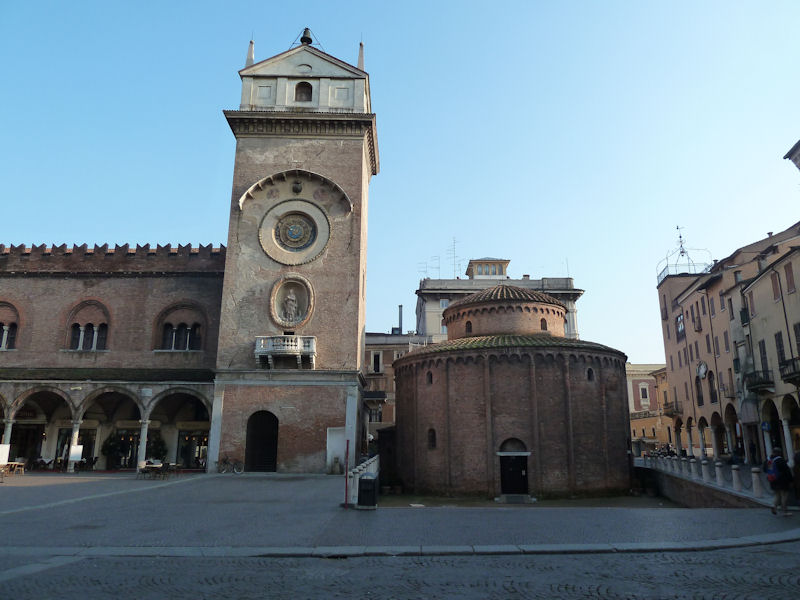Engulfed in sweaty crowds in mid-summer Florence more than 30 years ago, one has never gone back, but has always felt cheated.
So, since there's no winter in Switzerland anymore anyway, we'll try a February visit.





Mantua on the way home, February 2011

Firenze's main rail station, Stazione di Santa Maria Novella. It's time to leave Firenze, sob, and we're on our way, via Modena, to Mantua for a few days.

Beautiful Italian trains

Beautiful Italian train stations ("Silvio morto")

Kristin looking for our room in an alley (Vicolo Corridore) in the centre of Mantua. Not really, our host Luigino Gazzola fetched us from the rail station. He's an engineer who works from his office where Kristin is standing, and our apartment is behind the nearer door.

It's this one, a 'residenza di charme' -- called La Cervetta. If you plan ever to visit Mantua, Listen Up!

It's a splendid flat (renovated by our host and his wife) -- nothing wanting at all.

With a kitchen and all the mod cons (including WiFi). Very inexpensive, a few blocks from the Piazza delle Erbe, and with extremely friendly and interesting (and English-speaking) hosts.

We're out on a scoping mission, a quick reconnaissance of what's on offer in Mantova.

Mantua was an Etruscan trading centre, and later a Roman city for retired Augustan legionaries, and still later a free commune following the rule of the "Gran Contessa", Matilda of Canossa, of Tuscany in the early 12th century. The river Mincio was engineered, beginning in 1198, to create the Upper Lake (left, below), Middle Lake, and Lower Lake (right), with an artificial work across the southern end (since silted up or drained) to make the city virtually a defensible island.

The blue dot shows the Rio, a channel that cuts straight across the city, with the Giulio Romano bridge just west of the dot. In the old town, the entire area below and right of "Mantova" is the Ducal Palace of the Gonzaga rulers; the yellow dot is the central Piazza Sordello out front of it; the red dot is the Piazza delle Erbe, and the Basilica of Sant'Andrea is just above that. The orange dot shows our apartment, La Cervetta, close to all the action.

Kristin strolling through the Piazza Broletto (or medieval assembly place), looking along the Via Broletto through to the main square, the Piazza Sordello.

The Ducal Palace of the Gonzagas

The Duomo of San Pietro facing the Piazza Sordello -- the façade dates from the 1750s, but the present cathedral dates from about 1400, as renovated by Giulio Romano in about 1550.

Kristin playing operas in her head in the Teatro Scientifico, built in 1767-1769 by Bibiena, more or less inaugurated by a concert in 1769 by the 13-year-old Mozart.

The theatre is bell-shaped, thus better acoustics. We're told.

Nothing was on the programme during our stay, but it's nice to wander about inside anyway. And imagine the music if you can.

The Basilica of Sant'Andrea from alongside the Piazza delle Erbe

The dome of Sant'Andrea across the Piazza delle Erbe (herbs, from the ancient vegetable markets)

The dome

We're catching up on the news.

Now we're strolling along the shore of the Lago Inferiore, headed for the Gonzaga Palace for a quick look-in.

The belltower of the Palatine Basilica of Santa Barbara inside the Ducal Palace

The outside of the Ducal Palace facing the lake

The Castello di San Giorgio from the lakeside

The oldest part of the Ducal Palace complex, the Castle of San Giorgio (begun in 1390), later incorporated into the Gonzaga Palace campus

Where the Castello di San Giorgio joins the Ducal Palace


In the Corte Vecchio, with ice on the deck after the kids' ice-skating afternoon

Kristin exploring intra-Gonzaga courtyards

Kristin pacing Gonzaga corridors

Wonderful things to see in the (no-photos) Gonzaga Palace

The view out to the Mincio

The Piazza Sordello and the morning market

The Duomo

Nice church

Above the Piazza Sordello: the dome of Sant'Andrea and the Torre della Gabbia -- the Tower of the Cage (in the 16th century prisoners were displayed in a cage hung out on the outside of it; now faithfully recreated)

Time for lunch!

And no time like the present to make a reservation for tonight -- the Masseria, with remains of early frescoes on the walls.

In the sottopassagio behind the Palace of the Podestà

The Clock Tower and Rotonda, at the end of the . . .

Palazzo della Ragione, a merchants' row of shops dating from 1250, in the Piazza delle Erbe.

The Torre dell'Orologio, or Clock Tower, built in 1473.

And next to that, the Rotonda of San Lorenzo, a Romanesque church said to have been built in 1082 for Matilda di Canossa. Having been absorbed into the structure of later accretions in the neighborhood, it was resurrected in its glorious form in the early 20th century.

The interior of the Rotonda of San Lorenza. More on that later.

The Piazza Mantegna in front of the Basilica di Sant'Andrea, with well-meant police supervision. The façade was under wraps when we were there.

The Roman soldier who pierced Jesus' side with his spear was kind enough to bring some of the soil beneath the Cross, where the blood had splashed, here to Mantova, and these jars of sacred earth were happily rediscovered in 804. A sanctuary was quickly built, but the present church dates from the late 15th century.

Fancy a day out in Lourdes?

The dome of the basilica from the Piazza Leon Battista Alberti round the back

The dome

Kristin awaiting stragglers. We're setting out along the Walk of Princes, a mile or more of Via Roma, etc., etc., to what were once the suburbs, to see the Palazzo Te. That continues here.